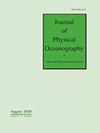A framework for constraining ocean mixing rates and overturning circulation from age tracers
IF 2.8
2区 地球科学
Q1 OCEANOGRAPHY
引用次数: 0
Abstract
The age of seawater refers to the amount of the time that has elapsed since that water encountered the surface. This age measures the ventilation rate of the ocean, and the spatial distribution of age can be influenced by multiple processes, such as the overturning circulation, ocean mixing, and air-sea exchange. In this work, we aim to gain new quantitative insights about how the ocean’s age tracer distribution reflects the strength of the meridional overturning circulation and diapycnal diffusivity. We propose an integral constraint that relates the age tracer flow across an isopycnal surface to the geometry of the surface. With the integral constraint, a relationship between the globally-averaged effective diapycnal diffusivity and the meridional overturning strength at an arbitrary density level can be inferred from the age tracer concentration near that level. The theory is tested in a set of idealized single-basin simulations. A key insight from this study is that the age difference between regions of upwelling and downwelling, rather than any single absolute age value, is the best indicator of overturning strength. The framework has also been adapted to estimate the strength of abyssal overturning circulation in the modern North Pacific, and we demonstrate that the age field provides an estimate of the circulation strength consistent with previous studies. This framework could potentially constrain ocean circulation and mixing rates from age-like realistic tracers (e.g., radiocarbon) in both past and present climates.利用年龄示踪剂制约海洋混合率和翻转环流的框架
海水年龄指的是海水进入海面后所经过的时间。海龄衡量了海洋的换气率,海龄的空间分布会受到多种过程的影响,如翻转环流、海洋混合和海气交换。在这项工作中,我们旨在获得关于海洋年龄示踪剂分布如何反映经向翻转环流和近岸扩散强度的新的定量见解。我们提出了一种积分约束条件,它将年龄示踪剂在等压面上的流动与等压面的几何形状联系起来。利用该积分约束条件,可以从某一密度水平附近的年龄示踪剂浓度推断出该密度水平的全球平均有效近地扩散率与经向翻转强度之间的关系。该理论在一组理想化的单流域模拟中得到了验证。这项研究的一个重要启示是,上升流和下降流区域之间的年龄差,而不是任何单一的绝对年龄值,是推翻强度的最佳指标。该框架还被用于估算现代北太平洋深海翻转环流的强度,我们证明年龄场提供的环流强度估算与之前的研究一致。这一框架有可能在过去和现在的气候条件下,通过类似年龄的现实示踪剂(如放射性碳)来制约海洋环流和混合率。
本文章由计算机程序翻译,如有差异,请以英文原文为准。
求助全文
约1分钟内获得全文
求助全文
来源期刊
CiteScore
2.40
自引率
20.00%
发文量
200
审稿时长
4.5 months
期刊介绍:
The Journal of Physical Oceanography (JPO) (ISSN: 0022-3670; eISSN: 1520-0485) publishes research related to the physics of the ocean and to processes operating at its boundaries. Observational, theoretical, and modeling studies are all welcome, especially those that focus on elucidating specific physical processes. Papers that investigate interactions with other components of the Earth system (e.g., ocean–atmosphere, physical–biological, and physical–chemical interactions) as well as studies of other fluid systems (e.g., lakes and laboratory tanks) are also invited, as long as their focus is on understanding the ocean or its role in the Earth system.

 求助内容:
求助内容: 应助结果提醒方式:
应助结果提醒方式:


